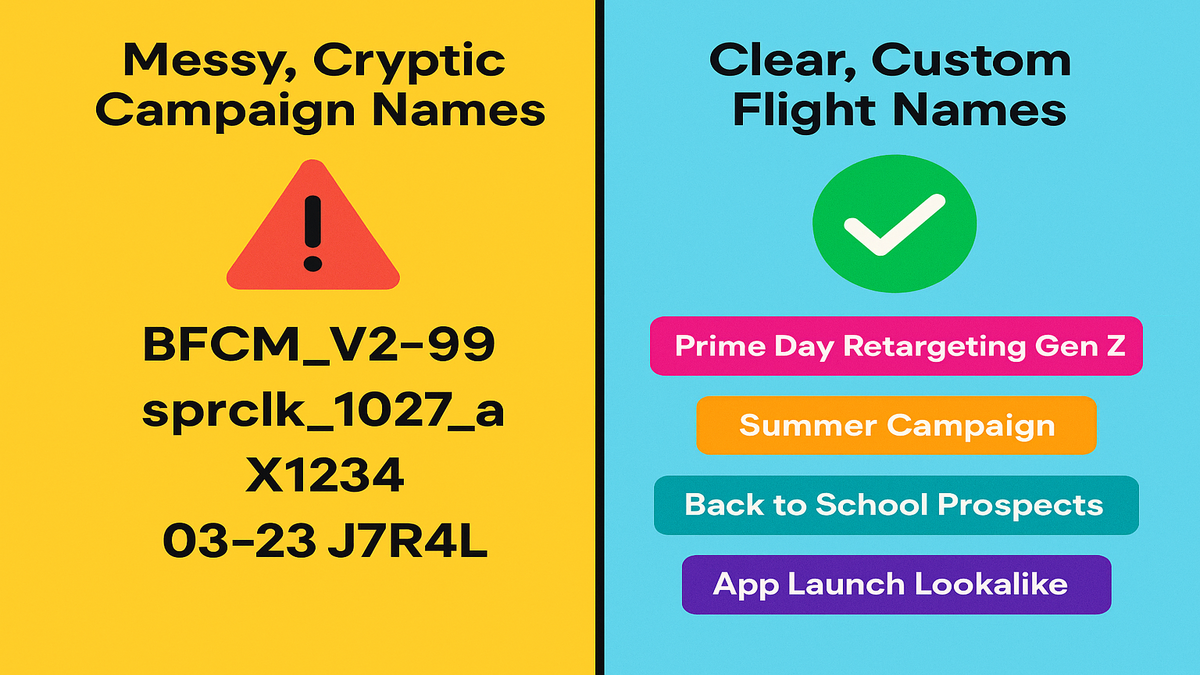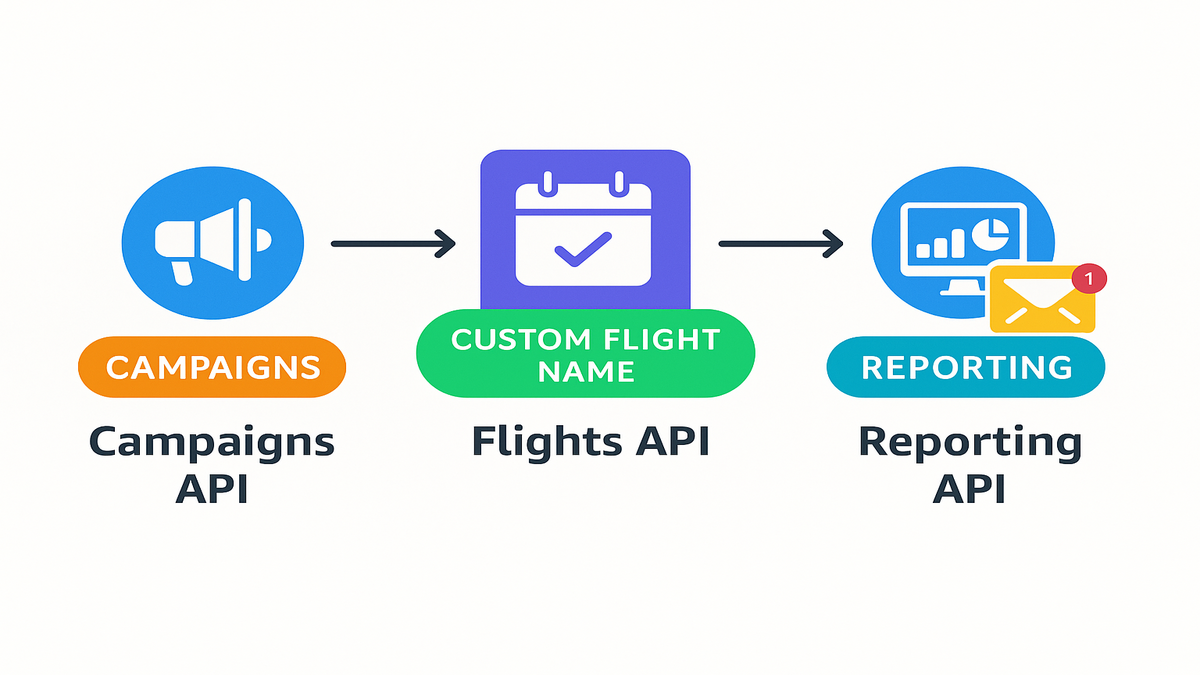
Unlock Campaign Clarity with Amazon DSP Custom Flight Names

Cut the noise for a sec—ever try juggling a handful of ad promos at once? Each one fighting for budget, all of them overlapping. Before you know it, your spreadsheets look wild, and your reports are a guessing game. No one knows what "BFCM_V2-99" even means anymore.
Sound like you? Trust me, loads of people live this mess. Whether you’re in an agency or on a brand team, tracking every campaign and dollar often feels like drowning in nickname soup. You battle lame codes and chase folks on Slack, all to answer, “Wait, what’s running now?”
Juggling tons of flights, clients, or brands in Amazon DSP? The new custom flight names feature will save your life. It’s not just a perk, it flips the script. Now you know where every dollar goes—right away. Reports get easier. Workflows finally make sense. No more breaking your brain over weird labels or old notes.
This isn’t "meh"—it’s a total fix for chaos. So, let’s talk about why custom labels are the glue holding pro ad teams together. And how you can own them like an Amazon Ads boss.
Key Takeaways
- Amazon DSP now lets you create your own flight names to keep track of campaigns.
- Custom names kill confusion and make reports crystal clear.
- Agencies with lots of brands get all campaigns lined up in one spot.
- Works with Campaigns, Flights, and Reporting APIs for smooth, automated flows.
- Using the same naming tricks everywhere drives teamwork and speed.
[Check out more Amazon DSP Services for smarter campaign moves.]

The Flight Name Revolution
Campaign Sanity
Let’s be real—default flight names are fine if you only have a few campaigns. Once you have a bunch, things fall apart. Think about 15 clients each rolling out their own seasonal stuff, splitting by region and creative type. That quick system? Toasted.
Before, flight names were either auto-generated or rushed. You got random things like “Q2_MarketingPush2” or, worse, "asdf12345." Your team wastes forever checking details. Reporting turns sloppy. By the time you match stuff up, you’ve already missed a campaign check or messed up spend.
Now, Amazon DSP lets you tag each flight your way. Suddenly, "Back-to-School Awareness East," or "Prime Day Retargeting Gen Z," or "Q3 Clearance Loyalty Push" show up in your dashboards. No more guessing at jumble. You see what you need right away, no digging around like a detective.
“Naming conventions aren’t just for clean desks—they’re how you keep stuff running right.” — Priya Patel, Senior Programmatic Manager at GrowthWave Media
Power User Wins
If you’re at an agency with more than 20 clients, custom flight names change the game:
- Spot problems at a glance: See "Summer Sale Snapchat" dragging behind "Spring Launch Mobile Only?" Fix it fast.
- Map budgets in seconds: Spend lines up with names. Forget hopping through five browser tabs or copy-pasting errors.
- Automated Alerts: Send flight names to Slack or Teams—if “Retargeting Moms Q2 West” is slow, everyone sees the same thing. No mixed up context.
With custom names, teams make less mistakes, spend less time fixing stuff, and actually work together. Strategy suddenly gets most of your headspace. Still not sure? Think about the hours spent every week just matching up which campaign is which. Multiply that work by all year. That’s the headache you remove.
Custom names don’t just clear up talk—they’re now the heart of any big, data-heavy ad setup.
Workflow Superpowers with the API
Where Names Plug In
This Amazon DSP boost isn’t just for dashboard fans. Custom names now travel through the Campaigns, Flights, and Reporting APIs. That means your names show up from the start, all the way to reports and dashboards.
- Campaigns API: Add or change flight names when you make or edit campaigns. No hack jobs in spreadsheets.
- Flights API: Search for flights by name for instant checks. Want to find a flight fast? Tag makes it easy.
- Reporting API: Pull down results already sorted your way. Tools like Google Data Studio, Power BI, or Tableau turn into one-step reports.
Agency Dashboards Auto-Pilot
See it in action: You run 30 DSP flights for nine brands, each split by region and goal.
Before, you’d chase campaign IDs, update sheets by hand, and triple-check everything.
Now:
- Your report pulls flight names daily from the API, every row clear.
- Real-time dashboards filter by campaign, region, or phase. "RetargetingAprilGenZ_Northwest" jumps out when you need it.
- Budget alerts and emails are automatic. No more manual touch because every tool talks to the same name structure.
Agencies say they save up to 60% in time after moving to smart naming and automatic reports. For some, weekly reporting drops from an hour to just 18 minutes. Multiply that by your number of flights, and you’ll understand why no one goes back to the old way.

Naming Tips for Big Impact
Your Naming System
Making up names as you go never ends well. Build a clear convention once and enforce it for every client, campaign, and team member. It’s the only way to avoid future migraines.
Try this:
- Be super clear: "Launch-Retargeting-W28-Millennials" tells you everything. "Retargeting1" is a nightmare.
- Use dates or codes: Tag with quarter, month, or phase—like "Q3-2024-BackToSchool" or "Aug2024_LoyaltyBoost." Makes the calendar work simple.
- Client/Brand up front: Agencies use formats like "ClientObjectiveFlightType_Date.” This way, new people on the team don’t need a cheat sheet.
- Audience tags: Pop in "CRM," “Prospect,” or any other clue. Reporting and billing get a lot clearer fast.
"Version control means you won’t mess up. Use custom names, and nobody edits the wrong flight ever." — Jamie N., Ad Tech Lead, Fireline Consulting
Insider’s tip: Check your naming playbook every few months. As you add brands or verticals, naming can drift. Standardize and document to keep things clean.
Example Template
Go for something like:
[Client/Brand]_[Goal/Phase]_[Audience]_[Region/Date]
“NikeBTSAffinityNortheast2024Q3” blows “Flight18” out of the water—especially at 2 a.m. with a board meeting looming.
Go From Chaos to Clear
Workflows Get Easier
Default flight ID? Get ready to triple-check every line of your report, hoping you didn’t mix up brands. With real names:
- Filter in seconds: Click once to filter your dashboard by campaign, region, or phase. Done.
- Pacing: Your dashboards and scripts use clear names. If "Q2ReminderSeniors_East" lags, you know ASAP—not after blowing your budget.
- Budgeting: Pull spend by flight, and the names match up with invoices, budgets, and reports. No guessing.
If you’re managing loads of campaigns during wild times (like Black Friday, Prime Day, or Back-to-School), this time savings is a life saver.
Link Names to Alerts
Skip boring codes—set up your reports or alerts to flag flights using actual labels.
- Slack, Teams, or email alerts with the real names—like "PrimeDayRetargetingMoms"—get your team moving right away.
- Custom names in dashboards mean automated warnings, so you never need to open up those color-coded panic spreadsheets again.
“Branded flight names got our report review time from 2 hours to just 15 minutes a week.” – Alicia Ramos, Reporting Director at AdNest
Budgeting Made Simple
Clear naming stops mistakes. It also brings teams together. Finance can match spend with projections in a heartbeat. Client service can answer questions right then. Managers spend less time fixing errors and more time finding ways to improve spend.
Micro-Summary: How Names Help
- Campaign confusion drops, and clarity takes over with tidy, personal labels
- Full API power lets you automate everything and speed up reporting
- Agencies and brands finally speak the same language, making onboarding easy
- Custom names give your data more meaning for reporting and budgeting
- Simple conventions + discipline = a campaign setup that’s ready to scale
Custom Names FAQ
How do I set a custom flight name in Amazon DSP?
Set names when you build flights in the UI or by passing the
customFlightNamefield in Campaigns or Flights APIs. It’s quick—just name as you go or edit.Can I automate reporting with these names?
Yep! The Reporting API pulls your custom names straight in, right labels every time. Dashboards, alerts, and billing all link up without manual checks.
Is this built for agencies with lots of clients?
Big yes. Add prefixes or client codes, and nothing gets tangled—even if promos or brands overlap. You’ll sleep better.
Any suggested naming formats from Amazon?
Amazon likes "BrandEventAudience_Date.” Agencies often add region or other clues—keep what’s clear, always. The only rule: be consistent.
Where’s the API info?
Check Amazon Ads’ official docs, especially the Flights and Reporting guides.
Will this make budgeting easier?
For sure. Flights grouped and tagged the smart way means mapping spend in one filter. Data lines up with budgets, invoices, and decks in seconds.
Name, Track, Win
- Pick Your Naming Structure: Write a sample, like
[Client]_[Objective]_[Audience]_[Date/Phase]. Make sure it’ll work for new clients or campaigns. - Set Up or Edit Flights: Use either the UI or API to start using your format. Go back and fix old names too.
- Update Reports: Make sure your dashboards and reports slice by the new flight name. No more sorting after download.
- Audit Every Quarter: Have ops or analytics check the naming. Growth means things change and need updates sometimes.
- Document and Teach: Write it down! Share how you name stuff, update onboarding, and remind your team. Goal: never ask “what’s Flight 17?” again.
Here’s the deal: custom flight names in Amazon DSP actually make your whole job easier—from day-to-day builds to the end-of-month scramble. Staying organized isn’t extra—it’s what helps you grow. Use API-driven names and get back more time to boost your results.
Ready to tidy up your Amazon Ads life? Dive into the Amazon DSP API or catch more tips in our guide on Amazon ads API reports and Amazon Marketing Stream.
See how smart brands and agencies are automating everything with AMC Cloud and built-for-you integration tools.

